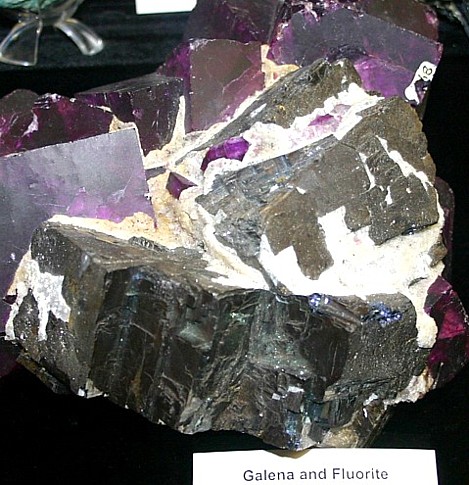
| FLUORITE MINERAL FACTS |  |
|
| The Gem and Mineral Collector's Photo Gallery by Nevada Outback |
|
. Fluorite Mineral Facts: Chemical Formula: CaF2 The Mineral is 48.9% Fluorine by weight. Colors: Shades of Purple, green, yellow, blue. Color widely various most commonly light green, yellow, bluish green or purple, also colorless, white, rose, blue, brown. A single crystal may show varying bands of color; the massive variety is also often banded in color. Hardness: 4 Density: 3.18 Cleavage: {111} perfect cleavage parallel to the cubic faces.
Crystallography: Isometric: Hexoctahedral Optics: (Refractive Index): 1.433 |
An Aggregate of Fluorite Crystals |
|
|
|
||
The color of the brightly tinted varieties is caused by extra or missing electrons in the crystal lattice, sometimes known as "electron holes". The bluish green varieties often show fluorescence (green by transmitted light, blue by reflected light). Some varieties phosphoresce when heated, giving off variously colored lights which are independent of the actual color of the specimen. Both of these effects are due to coloring electron excitation.
Identification and Diagnostics
Occurrence,
Localities and Origins: The more important deposits in the United States are in southern Illinois near Rosiclare, and in the adjacent part of Kentucky, where it occurs associated with zinc and lead ores. The fluorite occurs here in limestone, in fissure veins which at times become 40 feet in width. Other locations in the United States include veins on Long Island; in Blue Hill Bay, Maine; at Putney, in Vermont; at Plymouth, Conn.; at Lockport and Macomb, in New York; at Amelia Court House, Va.. Fluorite is found in quantity in England, chiefly from Cumberland, Derbyshire and Durham. Handsome crystallized specimens come from Cumberland and Derbyshire, England; Kongsberg, Norway; Cornwall, Wales, and from the mines of Saxony. These last-named localities, the neighborhood of Mabon Harbor, Nova Scotia, and Thunder Bay, Lake Superior, afford excellent crystal groups. Fluorite (Fluorspar) is used mainly as a flux in the making of steel, in the manufacture of opalescent glass, in enameling cooking utensils, for the preparation of hydrofluoric acid, and other chemicals. The brighter colored varieties are very rarely carved as an ornamental material in the form of vases, dishes, etc. Return to the Mineral Collectors Information Page |
Fluorite Crystals |
|
 Fluorite (purple) and Galena (Gray) Crystals |
||
Please note that the author, Chris Ralph, retains all copyrights to this entire document and it may not be reproduced, quoted or copied without permission.

NEVADA OUTBACK GEMS TURQUOISE AND JEWELRY